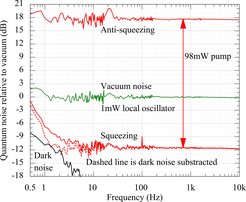Strongly squeezed light at 1550 nm
First time demonstration paves the way for excellent quantum noise reduction in future gravitational-wave detectors
While current gravitational-wave detectors rely on laser light at 1064 nm, future observatories such as the Einstein Telescope will employ lasers with a wavelength of 1550 nm to enable the use of cryogenically cooled silicon mirrors and beam splitters. Additionally, next-generation observatories will require strongly squeezed states of light to achieve a quantum noise reduction of about 10 dB. Now, a team of researchers at the AEI Hannover has demonstrated strongly squeezed laser light at a wavelength of 1550 nm. In their experiments, the research team reduced the quantum noise, for the first time at this wavelength, over the entire frequency measurement band of future ground-based gravitational-wave detectors by up to 11.5 dB. They tested two optical designs used for squeezed-light generation in current detectors. Their experiment generated even stronger squeezing of 13.5 dB at megahertz frequencies, which allowed the team to precisely constrain the quantum efficiency of the photodiode used. The results pave the way for improving and optimising quantum noise reduction in next-generation gravitational-wave detectors and, moreover, have applications in quantum information and cryptography.
Paper abstract

The generation of strongly squeezed vacuum states of light is a key technology for future ground- based gravitational wave detectors (GWDs) to reach sensitivities beyond their quantum noise limit. For some proposed observatory designs, an operating laser wavelength of 1550 nm or around 2 μm is required to enable the use of cryogenically cooled silicon test masses for thermal noise reduction. Here, we present for the first time the direct measurement of up to 11.5 dB squeezing at 1550 nm over the complete detection bandwidth of future ground-based GWDs ranging from 10 kHz down to below 1 Hz. Furthermore, we directly observe a quantum shot-noise reduction of up to (13.5 ± 0.1) dB at megahertz frequencies. This allows us to derive a precise constraint on the absolute quantum efficiency of the photodiode used for balanced homodyne detection. These results hold important insight regarding the quantum noise reduction efficiency in future GWDs, as well as for quantum information and cryptography, where low decoherence of nonclassical states of light is also of high relevance.
